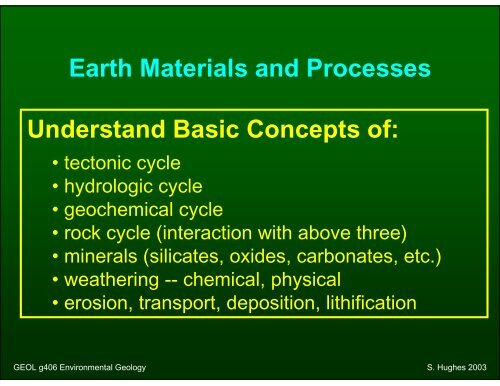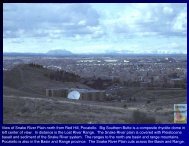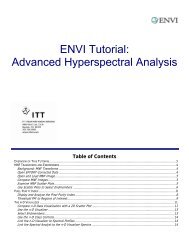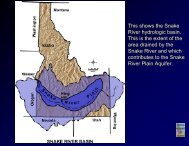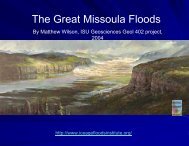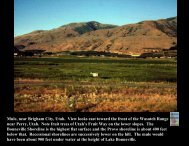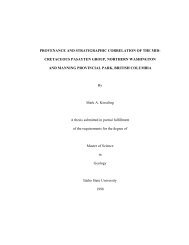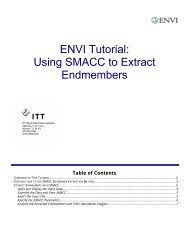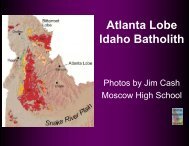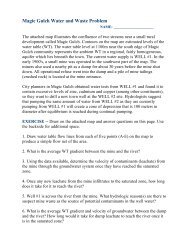Earth Materials and Processes Understand Basic Concepts of:
Earth Materials and Processes Understand Basic Concepts of:
Earth Materials and Processes Understand Basic Concepts of:
You also want an ePaper? Increase the reach of your titles
YUMPU automatically turns print PDFs into web optimized ePapers that Google loves.
<strong>Earth</strong> <strong>Materials</strong> <strong>and</strong> <strong>Processes</strong><br />
Underst<strong>and</strong> <strong>Basic</strong> <strong>Concepts</strong> <strong>of</strong>:<br />
• tectonic cycle<br />
• hydrologic cycle<br />
• geochemical cycle<br />
• rock cycle (interaction with above three)<br />
• minerals (silicates, oxides, carbonates, etc.)<br />
• weathering -- chemical, physical<br />
• erosion, transport, deposition, lithification<br />
GEOL g406 Environmental Geology S. Hughes 2003
Tectonic Plates, <strong>Earth</strong>quakes, <strong>and</strong> Active Volcanoes<br />
GEOL g406 Environmental Geology S. Hughes 2003
GEOL g406 Environmental Geology S. Hughes 2003
<strong>Earth</strong> <strong>Materials</strong> <strong>and</strong> <strong>Processes</strong><br />
The Rock Cycle<br />
Tectonism<br />
controls the rock<br />
cycle <strong>and</strong> is<br />
important to many<br />
surficial<br />
processes <strong>and</strong><br />
other <strong>Earth</strong><br />
Cycles.<br />
GEOL g406 Environmental Geology S. Hughes 2003
<strong>Earth</strong> <strong>Materials</strong> <strong>and</strong> <strong>Processes</strong><br />
The Hydrologic Cycle<br />
GEOL g406 Environmental Geology S. Hughes 2003
<strong>Earth</strong> <strong>Materials</strong> <strong>and</strong> <strong>Processes</strong><br />
The hydrologic cycle describes the movement<br />
<strong>of</strong> water between the mediums <strong>of</strong> atmosphere, earth,<br />
<strong>and</strong> ocean <strong>and</strong> back again. In the process, water<br />
erodes the l<strong>and</strong>, transports elements as sediment or in<br />
solution, <strong>and</strong> provides essential water resources for<br />
humans. Only 0.3 % <strong>of</strong> the total water in the cycle<br />
available for human use.<br />
QUESTIONS:<br />
• Fresh water makes up what proportion <strong>of</strong> total<br />
water on earth?<br />
• Approximately what percent <strong>of</strong> water worldwide is<br />
considered polluted?<br />
GEOL g406 Environmental Geology S. Hughes 2003
<strong>Earth</strong> <strong>Materials</strong> <strong>and</strong> <strong>Processes</strong><br />
The Biogeochemical Cycle traces the movement <strong>of</strong><br />
an element, like carbon, in the air, water, on <strong>and</strong> in the l<strong>and</strong>,<br />
<strong>and</strong> as used by living organisms. This issue is <strong>of</strong> particular<br />
importance today because large amounts <strong>of</strong> carbon dioxide<br />
are produced by burning fossil fuels. Many scientists are<br />
concerned that this trapped carbon dioxide may heat the earth<br />
in a process known as the "greenhouse effect."<br />
QUESTIONS:<br />
• How much carbon dioxide enters the <strong>Earth</strong>’s atmosphere<br />
each day?<br />
• What is carbon dioxide’s residence time in the<br />
atmosphere?<br />
• Where does the carbon "go" when its residence time in the<br />
atmosphere is over? (hint: check out the carbon cycle)<br />
GEOL g406 Environmental Geology S. Hughes 2003
Strength <strong>of</strong> Rocks<br />
GEOL g406 Environmental Geology S. Hughes 2003
<strong>Earth</strong> <strong>Materials</strong> <strong>and</strong> <strong>Processes</strong><br />
GEOL g406 Environmental Geology S. Hughes 2003
Strength <strong>of</strong> Rocks<br />
Rock strength is highly variable.<br />
Many Factors:<br />
• rock type<br />
•texture<br />
• chemical composition<br />
• internal structures<br />
• presence or absence <strong>of</strong> fluids<br />
Most rocks already fractured by joints <strong>and</strong> faults.<br />
Fractured rocks are only as strong as whatever is holding the<br />
rock together (gravity or friction).<br />
• fracture along planes <strong>of</strong> weakness<br />
• fracture along bedding planes or along foliation planes<br />
• orientation <strong>of</strong> planes <strong>of</strong> weakness is important, Why?<br />
GEOL g406 Environmental Geology S. Hughes 2003
Strength <strong>of</strong> Rocks<br />
Some common rocks, shales for example, may share the<br />
same name but have different engineering properties<br />
depending on their deposition as well as lithification<br />
processes.<br />
Compaction shales are weak <strong>and</strong> can slide along<br />
bedding planes, slake (s<strong>of</strong>ten into mud when wet), <strong>and</strong> swell<br />
under certain conditions.<br />
Cemented shales, depending on the cementing material,<br />
can be very strong <strong>and</strong> suitable for most engineering<br />
enterprises. Study the stress-strain diagrams carefully.<br />
Read Table 2.1 in the textbook.<br />
GEOL g406 Environmental Geology S. Hughes 2003
GEOL g406 Environmental Geology S. Hughes 2003
GEOL g406 Environmental Geology S. Hughes 2003
GEOL g406 Environmental Geology S. Hughes 2003
<strong>Earth</strong> <strong>Materials</strong> <strong>and</strong> <strong>Processes</strong><br />
Terms to Underst<strong>and</strong>:<br />
• hydrocompaction<br />
• geologic cycle<br />
• tectonic cycle<br />
• rock cycle<br />
• hydrologic cycle<br />
• biogeochemical cycle<br />
• greenhouse effect<br />
• rock strength<br />
• reliable strength<br />
• safety factor<br />
• stress <strong>and</strong> strain<br />
• ductile <strong>and</strong> brittle substances<br />
• elastic <strong>and</strong> plastic deformation<br />
• proportional elastic limit<br />
• ultimate strength<br />
• rupture strength<br />
Read Case Histories in the textbook:<br />
Baldwin Hills Dam <strong>and</strong> St. Francis Dam<br />
GEOL g406 Environmental Geology S. Hughes 2003


